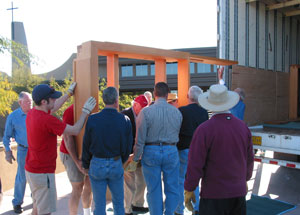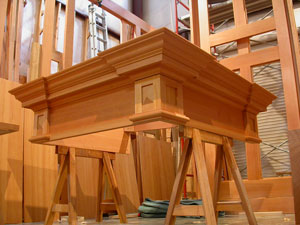In early March 2005, the much-anticipated arrival of the Richards, Fowkes & Co. Opus 14 organ became a reality. Dozens of volunteers worked tirelessly for two days to unload pipes and the thousands of pieces that make up the case work and inner workings of theinstrument from the large truck which had carried the precious cargo from Tennessee.

A smaller truck had delivered hundreds of pipes the previous month, and it soon appeared that every nook and cranny of the sanctuary building held a portion of this magnificent instrument. In less than a week, the framework of the case appeared on the wall, and in two weeks’ time, a few of the pipes were sounding. The organ was played in public for the first time on Easter Sunday, March 27, 2005, as organist Brent Hylton used the 8’ Gedact in song to escort the children out to their church school classes. From that humble beginning, the many different voices of the instrument began to emerge on an almost weekly basis as Bruce Fowkes painstakingly voiced each of the nearly 3500 pipes. The culmination of this nearly year-long process occurred with the liturgical dedication of the organ on January 8, 2006 and the dedicatory recital by David Higgs on January 15, 2006.
About the Builders
Richards, Fowkes & Co. was founded in 1988 in Ooltewah, Tennessee, a suburb of Chattanooga, nestled at the base of the Appalachians. It was there that Bruce Fowkes and Ralph Richards assembled a group of talented American and European craftsmen to build their mechanical action organs according to the principles of those built in northern Europe during the 17th and 18th centuries.

Many believe that the sound and construction of those historic instruments have set standards of excellence which have never been surpassed. With that ideal in mind, Richards, Fowkes & Co. continually study historic organs while exploring new ideas in organ building, all in an effort to make their instruments function as well as their historic ancestors. The Pinnacle Presbyterian Church organ is the fourteenth instrument the shop produced and the largest one to date.
About the Organ
The organ has 3364 pipes, divided into 72 ranks (sets) comprising 49 speaking stops. A Cymbelstern (a revolving star which rings bells) and a Vogelgesang (a bird song created by a short pipe blowing into water) are also included. The instrument is playable by direct mechanical key and stop actions on three manuals and pedal.

The pipes range in size from one-half inch to thirty-two feet in length and were cast of tin, lead, antimony, bismuth and copper, then planed and hammered. The wooden pipes were constructed of Douglas fir. The pipes are housed in a case made of old-growth Douglas fir from the Pacific Northwest which was quarter sawn, oiled and waxed. The keydesk, where the organist plays, is made of walnut with inlays of beeswing satinwood, and the keys themselves are made of ebony and cow bone. Two keycheek carvings of Zephyrus, the Greek god of wind, adorn each side of the keyboards. They were hand carved from black walnut.

The winding system is located in a sound-proof room behind the back wall of the organ. Four single-fold wedge bellows contain and control the organ’s wind supply with a slight degree of flexibility. Stabilizers may be added when a steadier supply is desired. Poplar wind lines bring pressurized air to the windchests.
The blower which feeds the bellows was built in Germany. The remaining thousands of parts were made at the shop in Ooltewah, where the craftsmen used centuries’ old techniques aided by computer drafting and modeling. The entire project took nearly seven years from inception to completion.
About the Carvings

The carvings on the instrument are based on southwest Indian motifs realized in the classical European aesthetic of symmetry, motion and proportion to harmonize the traditional structure of the pipe organ with the native surroundings. The main element in the design is the rain bird, chosen as the metaphor to symbolize rain in the desert. Based on Hopi precedents, it is recognizable within the carvings as an inward curved head and beak with two large stylized feathers pointing upward. These elements were then combined to create the bulk of the carving seen. Also, in keeping with the rain motif, there are two rain serpents in “san ildefonso” tradition at the top center of the organ on either side of the central star/sun. Almost forgotten, at the bottom of the four largest vertical posts, are geckos to symbolize the ground or earth.
Most prominent, however, are the four large gilded circles with an anthropomorphic cartouche in the center. According to ancient church tradition, the four authors of the Gospels were represented by symbols which depict the four aspects of the same Christ: Jesus as human in birth (the man) and as a sacrificial victim in death (the ox); strong and powerful in his resurrection (the lion) and rising to the Father in his ascension (the eagle). Above (l-r), the man (Matthew), the lion (Mark), the ox (Luke), and the eagle (John) are based on Indian concepts of design and form which are most often seen in their pottery.

In the rectangular ‘boxes’ below the groupings of smaller pipes are again found feathers from the rain bird. This time they are overlaid with one of the four Hebrew letters constituting the name of God, “Yahweh” or Jehovah: yud hey vahv hey, also known as the Tetragrammaton. These can be read starting in the upper right hand corner and reading in a counterclockwise direction. Thus, the rays of sun and God are both above all things while God himself is IN all things.
In this age of mass production, this magnificent organ stands as a testimony of the quality and care these builders took to produce an instrument which will bring beauty in sight and sound for years to come.








